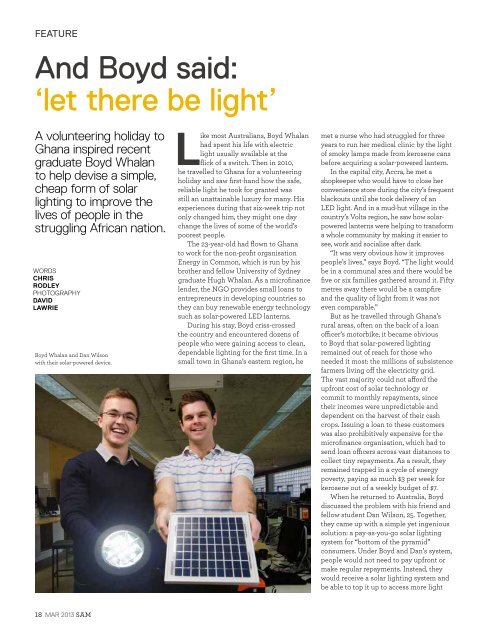Download PDF - The University of Sydney
Download PDF - The University of Sydney
Download PDF - The University of Sydney
Create successful ePaper yourself
Turn your PDF publications into a flip-book with our unique Google optimized e-Paper software.
feature<br />
And Boyd said:<br />
‘let there be light’<br />
A volunteering holiday to<br />
Ghana inspired recent<br />
graduate Boyd Whalan<br />
to help devise a simple,<br />
cheap form <strong>of</strong> solar<br />
lighting to improve the<br />
lives <strong>of</strong> people in the<br />
struggling African nation.<br />
words<br />
chris<br />
rodley<br />
PHOTOGRAPHY<br />
david<br />
lawrie<br />
Boyd Whalan and Dan Wilson<br />
with their solar-powered device.<br />
Like most Australians, Boyd Whalan<br />
had spent his life with electric<br />
light usually available at the<br />
flick <strong>of</strong> a switch. <strong>The</strong>n in 2010,<br />
he travelled to Ghana for a volunteering<br />
holiday and saw first-hand how the safe,<br />
reliable light he took for granted was<br />
still an unattainable luxury for many. His<br />
experiences during that six-week trip not<br />
only changed him, they might one day<br />
change the lives <strong>of</strong> some <strong>of</strong> the world’s<br />
poorest people.<br />
<strong>The</strong> 23-year-old had flown to Ghana<br />
to work for the non-pr<strong>of</strong>it organisation<br />
Energy in Common, which is run by his<br />
brother and fellow <strong>University</strong> <strong>of</strong> <strong>Sydney</strong><br />
graduate Hugh Whalan. As a micr<strong>of</strong>inance<br />
lender, the NGO provides small loans to<br />
entrepreneurs in developing countries so<br />
they can buy renewable energy technology<br />
such as solar-powered LED lanterns.<br />
During his stay, Boyd criss-crossed<br />
the country and encountered dozens <strong>of</strong><br />
people who were gaining access to clean,<br />
dependable lighting for the first time. In a<br />
small town in Ghana’s eastern region, he<br />
met a nurse who had struggled for three<br />
years to run her medical clinic by the light<br />
<strong>of</strong> smoky lamps made from kerosene cans<br />
before acquiring a solar-powered lantern.<br />
In the capital city, Accra, he met a<br />
shopkeeper who would have to close her<br />
convenience store during the city’s frequent<br />
blackouts until she took delivery <strong>of</strong> an<br />
LED light. And in a mud-hut village in the<br />
country’s Volta region, he saw how solarpowered<br />
lanterns were helping to transform<br />
a whole community by making it easier to<br />
see, work and socialise after dark.<br />
“It was very obvious how it improves<br />
people’s lives,” says Boyd. “<strong>The</strong> light would<br />
be in a communal area and there would be<br />
five or six families gathered around it. Fifty<br />
metres away there would be a campfire<br />
and the quality <strong>of</strong> light from it was not<br />
even comparable.”<br />
But as he travelled through Ghana’s<br />
rural areas, <strong>of</strong>ten on the back <strong>of</strong> a loan<br />
<strong>of</strong>ficer’s motorbike, it became obvious<br />
to Boyd that solar-powered lighting<br />
remained out <strong>of</strong> reach for those who<br />
needed it most: the millions <strong>of</strong> subsistence<br />
farmers living <strong>of</strong>f the electricity grid.<br />
<strong>The</strong> vast majority could not afford the<br />
upfront cost <strong>of</strong> solar technology or<br />
commit to monthly repayments, since<br />
their incomes were unpredictable and<br />
dependent on the harvest <strong>of</strong> their cash<br />
crops. Issuing a loan to these customers<br />
was also prohibitively expensive for the<br />
micr<strong>of</strong>inance organisation, which had to<br />
send loan <strong>of</strong>ficers across vast distances to<br />
collect tiny repayments. As a result, they<br />
remained trapped in a cycle <strong>of</strong> energy<br />
poverty, paying as much $3 per week for<br />
kerosene out <strong>of</strong> a weekly budget <strong>of</strong> $7.<br />
When he returned to Australia, Boyd<br />
discussed the problem with his friend and<br />
fellow student Dan Wilson, 25. Together,<br />
they came up with a simple yet ingenious<br />
solution: a pay-as-you-go solar lighting<br />
system for “bottom <strong>of</strong> the pyramid”<br />
consumers. Under Boyd and Dan’s system,<br />
people would not need to pay upfront or<br />
make regular repayments. Instead, they<br />
would receive a solar lighting system and<br />
be able to top it up to access more light<br />
18 mar 2013 SAM
















